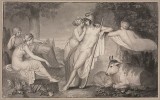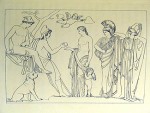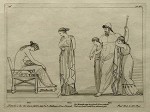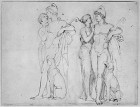The browser will either open the file, download it, or display a dialog.
One of the seminal figures of Neoclassicism, John Flaxman (1755–1826) identified himself first and foremost as a sculptor, and yet his greatest fame and most lasting influence rest with his drawings. While commissions for sculpture were difficult to obtain and expensive to fulfill, Flaxman’s illustrations to the classical epics of Homer, Aeschylus, Dante, and Hesiod were less cumbersome and provided more immediate financial reward. These drawings became his most celebrated work during his lifetime, and although they were not the work of which he was most proud,[1] they encapsulate his philosophy and style. The engravings made after Flaxman’s spare designs would revolutionize the art of drawing and spread his stylized linearity widely, influencing artists as diverse as Jean-Auguste-Dominique Ingres, the Nazarenes, the later Pre-Raphaelites, Walter Crane, and Aubrey Beardsley.[2] A highly finished drawing recently acquired by the Cleveland Museum of Art that exemplifies Flaxman’s Neoclassical style will be the subject of this article (fig. 1). While initially the subject of the drawing appears to be the Judgment of Paris from Homer’s Illiad, I will propose an alternative reading of the narrative, drawing from a more obscure classical text by Quintus Symrnaeus (or Quintus of Smyrna). The article will also address the drawing’s early provenance and its expression of Flaxman’s artistic philosophy.
According to Flaxman’s first biographer, Allan Cunningham, a sustained and serious interest in drawing and sculpture became evident early in the artist’s life. A fragile child who suffered from scoliosis, he spent much of his youth drawing in the studio of his father, an eminent plaster-cast maker in Covent Garden. The precocious child did not limit himself to copying the casts around him, but read Homer and attempted to think and design for himself.[3] The young Flaxman entered the Royal Academy Schools in 1770 and was awarded a silver medal, but was not the recipient of the coveted Prix de Rome.[4] From the mid-1770s, he worked as a designer for Josiah Wedgwood, modeling portrait medallions of illustrious personages of the eighteenth century and creating original jasperware bas-reliefs that decorated mantelpieces and vases.[5] This commercial work helped Flaxman achieve financial independence and gave him access to Wedgwood’s lavish, four-volume set of books on Sir William Hamilton’s Neapolitan collection of Greek vases that was sold to the British Museum in 1772.[6] Flaxman appropriated the elegance and simplicity of the classical vase paintings, while subtle alterations made the work his own.
The work for Wedgwood proved significant in the progression of Flaxman’s career. It instilled a keen desire to work from the antique in Italy and taught him to use linear simplification as a means through which to think simultaneously in two and three dimensions. Drawing became fundamental to Flaxman’s practice as a designer and sculptor. In London he established friendships with contemporaries William Blake and Thomas Stothard,[7] for whom illustration was an important aspect of their artistic activity. Following their examples, illustration became a part of his artistic practice in the mid-1880s when he made a number of drawings in pen and wash illustrating Thomas Chatterton’s Romantic poem, The Battle of Hastyngs as well as drawings illustrating Thomas Percy’s collection of medieval and traditional ballads, Reliques of Ancient English Poetry. For the young, voracious reader[8], favorite texts—poems in particular—were sources to be mined for imagery.
In 1787, Flaxman and his wife traveled to Italy where they remained for nearly eight years. Before settling in Rome, their Grand Tour took them through Normandy and Tuscany where Flaxman filled numerous sketchbooks with copies of Renaissance sculpture and frescoes.[9] Initially, he found it difficult to obtain commissions for sculpture, and supplementing his income became essential. As the commercial work for Wedgewood had enabled the artist to go to Italy, commissions for illustrations to accompany classical texts made it possible to remain abroad. By 1792, he was working on numerous projects commissioned by British patrons residing in Italy.[10] Mrs. Hare-Naylor commissioned illustrations to the Iliad and the Odyssey. Flaxman’s spare, linear drawings were engraved by Tomasso Piroil and published in two volumes in 1793. He was paid fifteen shilling for each drawing, but the fame they elicited far outweighed the recompense.[11] Flaxman made a second set of illustrations to Homer’s epics for Robert Fullerton Udney, a connoisseur and collector. More highly worked, modeled and completed with wash, this group of drawings was not intended for engraving or publication.[12] Commissions for classical texts continued, and Flaxman’s illustrations for the tragedies of Aeschylus were first published in 1795 and reprinted many times.[13]
Flaxman was most active as a draftsman during his years in Rome. The majority of his surviving drawings were made there in the early 1790s. In addition to his “outlines,” as he referred to his designs for illustrations, he also executed a considerable number of life studies, particularly of standing male figures and female figures with children.[14] While many of his drawings were preliminary studies for sculpture, decorative arts, or illustrations, some cannot be linked to other projects. As early as 1789 in Rome, Flaxman was engaged in making a series of drawings in pen and wash inspired by Euripides; whether they were made to fulfill a commission is not known.[15] According to his wife’s letters, Flaxman worked on sculpture during the day in the studio and drew at night at home.[16]
The highly finished Cleveland sheet is quintessentially Neoclassical in subject and conception. A group of figures in a frieze-like arrangement is depicted in a pastoral setting. The design was executed in black-gray ink and wash with graphite and touches of brown ink on a laid paper, adhered to a decorative mount. Such drawings combining pen and monochromatic wash were a favorite medium for the artist throughout his career. In this sheet, he began with a delicate underdrawing in graphite, reinforcing the contours of the figures with a gray ink line. The delicate line work precisely describes the details of each lock of hair and fold of drapery. Although linearity is an essential aspect of the drawing, the subtle use of ink wash conveys volume, particularly in the figures. An abbreviated landscape—a canopy of trees and lush foreground vegetation—frames the scene, not unlike a set design for the stage.
Multiple readings of the iconography of the Cleveland drawing are possible. Paris of Troy, the only male figure in the composition, is easily identified by his Phrygian cap and staff, and by the prominent position of his favorite bull. A group of female figures has converged around him. The most obvious reading of the scene is a Judgment of Paris, with the triumphant Aphrodite in Paris's arms and Athena and Hera looking on at the left. However, the absence of the ubiquitous Hermes and the golden apple complicates this reading. In a second edition of The Iliad published in 1805 by Longman, Hurst, Rees & Orme, Flaxman added five additional outline drawings, including The Judgment of Paris in which the messenger of the gods and the apple feature prominently (fig. 2). Although this outline post-dates the Cleveland sheet, the erudite Flaxman was well aware of the components needed to identify a classical subject.
There are, however, distinct compositional similarities between the Cleveland sheet and Thetis Welcomed by Hephaestus, Flaxman’s design for plate twenty-six of The Iliad, drawn in 1792 (fig. 3).Inscribed, “The Monarch’s steps two female forms uphold / That mov’d and breath’d in animated gold,” Flaxman’s outline illustrates Book 18, lines 410–27 in which the goddess Charis presents Thetis, wife of Peleus and mother of Achilles, to her husband, Hephaestus. Flaxman remained close to Homer’s text, showing the bereft Thetis seated on “a silver studded chair, elaborately worked, a footstool beneath” and the lame god clutching a sturdy staff, “limping supported by two servants of gold, like two living girls.”[17] Although unrelated in narrative, the compositions of the Cleveland sheet and the outline drawing are strikingly similar. The seated Thetis in the outline corresponds to the seated female nude at the left of the Cleveland drawing; both figures are described in profile, backs gently curved with a long, elegant arm balanced on an outstretched knee. Likewise, the figure of Hephaestus stands in much the same position as Paris in the Cleveland sheet. While the Greek god’s right arm encircles a servant girl for support, Paris's similar gesture suggests desire more than need. Hephaestus, the god of blacksmiths, artisans, and sculptors, would have carried special resonance for Flaxman the sculptor. On a more personal level, Flaxman, whose own physical imperfection was a source of distress, may have seem himself in the lame Hephaestus, the only Greek god who lacked beauty. It would seem that in designing the illustration for “Thetis Welcomed by Hephaestus,” Flaxman borrowed from the highly finished Cleveland sheet, executed just months earlier. His transformation of Paris, idealized and graceful, into Hephaestus, the lame artist-god, once banished from Olympus, is significant and will be addressed in the conclusion of the article.
A comparison with yet another drawing suggests an alternative reading of the iconography of the Cleveland drawing. The embracing figures central to the drawing are echoed in a study in the collection of the Huntington Library and Art Gallery, San Marino. Design for Paris and Oenone [?], which contains two views of the same pair of figures from different angles, suggesting a sketch for a three dimensional object (fig. 4).[18] Although no known sculpture featuring this pair is known, according to one of Flaxman’s account books, he made a drawing of Paris and Oenone for the silversmiths Rundell, Bridge, and Rundell, for which he was paid on January 10, 1824.[19]
Flaxman had an unusually keen memory and returned to favorite motifs throughout his career. His illustrations were constructed from copies of classical sculpture recorded in notebooks and from recollections of works of art, sometimes seen decades before.[20] The connection with the Huntington sketch suggests that Oenone, the daughter of the river-god Cebren, is the figure embraced by Paris in the Cleveland drawing. While living in obscurity on Mount Ida, the shepherd fell in love with the nymph, Oenone, and together they had a son, Corythus. When called upon by Zeus to judge the beauty of Hera, Athena, and Aphrodite, Paris forsook Oenone for the love of Helen of Sparta, wife of King Menelaus, promised him by Aphrodite. The clairvoyant Oenone cautioned Paris that one day he would be wounded and only she, with her knowledge of herbal medicine, would be able to heal him. Heedless of the warning, Paris eloped with Helen, thus setting off the Trojan War. But, as told by Quintus of Smyrna in his 4th century text, Posthomerica (The Fall of Troy), Paris's desertion of Oenone elicited tragic consequences. Injured by one of Philoctetes’s arrows during the siege of Troy, he recalled the nymph’s augury, and pleaded to her for her help:
Have a merciful heart and stop my terrible pain
By applying healing salves to the mortal wound[21]
. . . . . . . . . . . . . . . . . . . . . . . . . . . . . . . . . . . . . .
Your heart alone must make the decision
Whether to save me from a miserable death or not.[22]
. . . . . . . . . . . . . . . . . . . . . . . . . . . . . . . . . . . . . . . . . . .
Hurry, my lady, and stop the evil Fates,
Even though I did you wrong in my folly.[23]
With vengeance, the spurned Oenone refused Paris's pleas, sending him back to Helen:
Hurry to her with your entreaty; it isn’t me
You must persuade with your tears and pitiful tale of woe.
I wish I had the heart and strength of a savage beast,
First to tear your flesh and then to lap your blood
For the way you made me suffer with your willful folly.[24]
But the nymph regrets her heard-heartedness, and of all those who mourned the loss of Paris, Oenone’s grief was keenest:
As in woodlands on the highest hills ice forms
From snow that has been sprinkled over many valleys
By gusts of wind from the west, but when the surrounding
Mountain heights are soaked with flowing water,
Then the ice in the glens, however thick it is,
Is melted into a stream of ice-cold water;
Like that Oenone, in her terrible pain and anguish,
Melted with grief for the husband she had wed.[25]
In despair, she throws herself on Paris's funeral pyre under the gaze of her handmaidens:
Oenone then,
Seeing him clearly, uttered no sound in spite of her grief,
Used her robe to cover her lovely face
And leapt upon the pyre, which made them all groan aloud.
She was buried at her husband’s side. . . .[26]
Well versed in classical literature—Flaxman had learned Greek in order to read in the original the poetry that inspired his drawings[27]—Flaxman could have known Quintus of Smyrna’s epic poem that brought completion to The Iliad, continuing the narrative after the death of Hector. I propose an alternative reading of the Cleveland drawing in which the scene precedes the Judgment of Paris, imagining an amorous Paris and Oenone with two of the nymph’s handmaidens in attendance. The couple’s intense gaze meets at the center of the composition, their idealized profiles echoing one another’s. Their bodies are entwined, Oenone’s hands clasped against each of Paris's shoulders, one resting among his dark curls, as he encircles her in an embrace. The beauty of their forms and intimacy of their pose are the focal point of the composition. In an image depicting the Judgment of Paris, each of the three goddesses would typically be given equal attention, and Paris would not be shown enraptured by Aphrodite.
The figure at the right above the bull is somewhat ambiguous. While Paris, Oneone, the handmaidens, and even the bull and sleeping dog are rendered in painstaking detail, the reclining figure seen from the back remains schematic. The hair and profile lack specificity; the body is without complex and subtle shading, rendering the figure sculptural and lifeless. Artists have traditionally depicted Paris in a woodland setting beside a fountain.[28] The way that Paris rests his elbow against the figure suggests a fountain in the form of a reclining nude. The juxtaposition of lifelike figures with one rendered in marble underscored Flaxman’s powerful draftsmanship. The continuous linear contours, rhythmic organization, and lack of suggestion of depth in the surrounding landscape that characterize the Cleveland drawing are qualities typical of the sculptor’s best drawings. Although often considered a cool and distant artist, the suggestion of intense emotion and the sublime beauty of the figures in this sheet reveal often- overlooked Romantic overtones in Flaxman’s work.
If the Cleveland drawing was Flaxman’s first iteration of the Oenone theme, and if he borrowed from the composition when executing his illustration, Thetis Welcomed by Hephaestus, for The Iliad, and even later for a design commissioned by Rundell, Bridge, and Rundell, for what purpose was the Cleveland drawing made? In May 1791, Flaxman sent his patron Edward Knight, in London, ten highly-finished drawings after antique bas-reliefs.[29] While the Cleveland drawing was not drawn after a bas-relief, the elaborateness with which it was worked, the fact that it is signed, dated 1791, inscribed “Roma,” and framed within a carefully delineated border, identifies it as a finished work of art that, knowing Flaxman’s need for money while in Rome, was likely made for sale. The drawing bears the collector’s mark of the marquis de Lagoy (1764–1829) of Aix-en-Provence, who amassed a collection of more than 3,000 drawings by more than 800 different artists of all periods and schools at the end of the eighteenth century and the beginning of the nineteenth.[30] An old mount bears the notation: “Acheté a Roma” (purchased in Rome). In Paris, Lagoy met a Dutchman, Willem Anne Lestevenon, who was an erudite connoisseur.[31] In 1784, Lestevenon was sent to Italy by the newly established Teyler Foundation in Haarlem, and traveled to Rome, Bologna, Venice, and Naples to acquire art and objects of scientific interest.[32] Lestevenon also avidly collected drawings for himself, and in turn sold many drawings to the marquis de Lagoy. Ending his Italian tour in 1791, Lestevenon left Rome and returned to northern Europe. Financially ruined in 1805, he sold most of his collection to Lagoy.[33] Given Lestevenon’s movements in Italy, he probably purchased the drawing in Rome in 1791, and subsequently sold it to the ambitious French collector.
The singular purity, elegance of line, delicacy of washes, and degree of detail render the drawing extraordinary. Its beauty astonishes. Beauty was an ideal that preoccupied Flaxman from the early years of his career. He became the first professor of sculpture at the Royal Academy in 1810, and between 1811 and 1826 gave a series of lectures, published soon after his death, on the history of sculpture in Egypt, Greece, and England, including such topics as composition and style, and devoting an entire lecture to the fall and flow of drapery.[34]
His lecture, “Beauty,” is pertinent to a discussion of the Cleveland drawing. Flaxman identified beauty as “not merely an imaginary quality, but a real essence,”[35] and, citing examples from classical poetry, discussed the connection between mental and physical beauty and its expression in the human form. For Flaxman, “The most perfect human beauty is that most free from deformity either of body or mind, and may be therefore defined, ‘The most perfect soul, in the most perfect body.’” [36] Himself physically imperfect, there is poignant irony in Flaxman’s adherence to the Platonic ideal, “nothing is beautiful which is not good.” The Cleveland drawing is ultimately about beauty and all of its complexities; the figures of Paris and Oenone are quintessential examples of austere Neoclassical loveliness, and yet it is the question of which goddess was the most celestially beautiful that is the ultimate undoing of their happiness. Flaxman concluded his lecture, “Beauty,” by noting, “the sea nymphs are graceful in the extreme: their beautiful movements are as various as the waves on which they are borne; each appears a foam-produced Venus.”[37] Indeed, the artist might have been describing this very drawing, whose female figures are sublimely beautiful, their languid limbs the epitome of Neoclassical elegance.
[1] Flaxman alluded to his view of himself as first and foremost a sculptor in a letter from the autumn of 1793 to Thomas Haley: “My view does not terminate in giving a few outlines to the world: my intention is to shew how any story may be represented in a series of compositions on principles of the Ancients, of which as soon as I return to England I intend to give specimens in Sculpture of different kinds, in groups of bas-relieves, suited to all the purposes of Sacred and Civil Architecture.” Unpublished correspondence quoted in David Bindman, ed., John Flaxman, Royal Academy of Arts, exh. cat. (London: Thames and Hudson, 1979), 86.
[2] Flaxman’s influence on subsequent artists has been addressed in Margaret Whinney, “Flaxman and the Eighteenth Century,” Journal of the Courtauld-Warburg Institute 19, no. 3/4 (July/December 1956): 269–82; Sarah Symmons, Flaxman and Europe: The Outline Illustrations and their Influence (New York and London: Garland Publishing, 1984); and Daniel O. Bell, A Pious Bacchanal: Affinities between the Lives and Works of John Flaxman and Aubrey Beardsley (New York: Peter Land Publishing, 2000).
[3] Allan Cunningham, The Lives of the Most Eminent British Painters, Sculptors, and Architects (London: John Murray, 1830), 3:275.
[4] As a young artist, Flaxman was a stronger draftsman than a sculptor. “At twenty years of age he had sent only ten pieces to the Academy; but his skill during that period was greater with the pencil than with the modeling tool.” Cunningham, Lives of the Most Eminent British Painters, 3:282.
[5] For a discussion of Flaxman’s work for Wedgwood, see David Irwin, “Artist and Industry: Wedgwood,”in John Flaxman 1755–1826 (London: Studio Vista, 1979), 18–28.
[6] Ibid., 23.
[7] Ibid., 6.
[8] Cunningham referred to the Flaxman as a “solitary child [who] labored at his books and models incessantly.” Cunningham, Lives of the Most Eminent British Painters, 3:277.
[9] Irwin discusses Flaxman’s travels and sketchbooks made throughout his travels in Italy in “To Italy,” in John Flaxman 1755–1826, 29–53.
[10] Irwin elucidates Flaxman’s illustrations in “Illustrations,” in John Flaxman 1755–1826 67–122.
[11] Cunningham, Lives of the Most Eminent British Painters, 3:301.
[12] Irwin, John Flaxman 1755–1826,68.
[13] Ibid., 87.
[14] Robert R. Wark, Drawings by John Flaxman in the Huntington Collection (San Marino: Henry E. Huntington Library and Art Gallery, 1970), 13. Today, Flaxman’s Italian drawings may be found in the collections at University College, London; the Victoria and Albert Museum, London; and the Huntington Collection, San Marino.
[15] Irwin, John Flaxman 1755–1826,67.
[16] Unpublished letter, Mrs. Flaxman to Maria Denman, Dec. 15, 1792, Correspondence, 1780–1825, B. M. Add Mss 39780f. 197, British Library, London. Cited in Symmons, Flaxman and Europe, 101.
[17] Michael Reck, trans., The Iliad of Homer (New York: Harper Collins, 1994), 18.417–18.
[18] I am grateful to Monroe Warshaw for bringing this sheet to my attention.
[19] “Account Book of John Flaxman, 1808–1826,” 77, Columbia University, unpublished but available on microfilm, Ms MONTGOM 301. Cited in Wark, Drawings by John Flaxman, 81.
[20] Symmons, Flaxman and Europe, 85.
[21] Quintus of Smyrna, The Trojan Epic Posthomerica, trans. and ed. Alan James (Baltimore and London: Johns Hopkins University Press, 2004), 10.291–92.
[22] Ibid., 10.294–95.
[23] Ibid., 10.304–5.
[24] Ibid., 10.313–17.
[25] Ibid., 10.415–22.
[26] Ibid., 10.464–68.
[27] Irwin, John Flaxman 1755–1826, 69.
[28] Pierre Grimal, Dictionary of Classical Mythology, trans. A. R. Maxwell-Hyslop (Oxford; Blackwell Publishers Ltd., 1985), 345.
[29] Irwin, John Flaxman 1755–1826, 45. An entry in a sketchbook in the collection of the Yale Center for British art shows that Flaxman was paid £28.17s for the ten drawings.
[30] Frits Lugt, Les Marques de Collections de Dessins and d’Estampes (Amsterdam: Vereenigde Drukkerijen, 1921), 308–9 (cat no. 1710).
[31] For a thorough discussion of the marquis de Lagoy’s collection, see Béatrice de Moustier, “The Italian Drawings Collection of the Marquis de Lagoy,” Master Drawings 46, no. 2 (2008): 187–204.
[32] Ibid., 194.
[33] Ibid., 197.
[34] Irwin discusses Flaxman’s career at the Royal Academy in “Professor of Sculpture,” in John Flaxman 1755–1826, 204.
[35] John Flaxman, Lectures on Sculpture (London: John Murray, 1829), 134.
[36] Ibid., 142–43.
[37] Ibid., 155.






